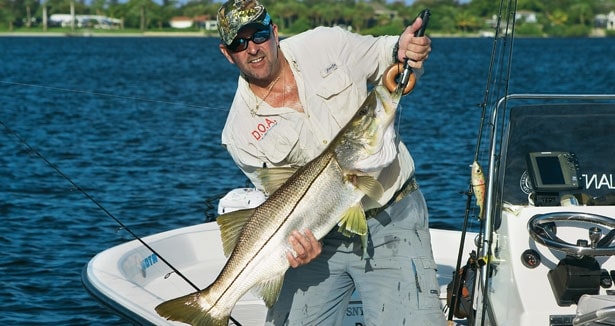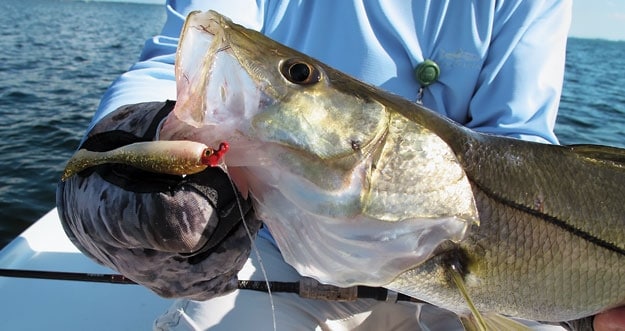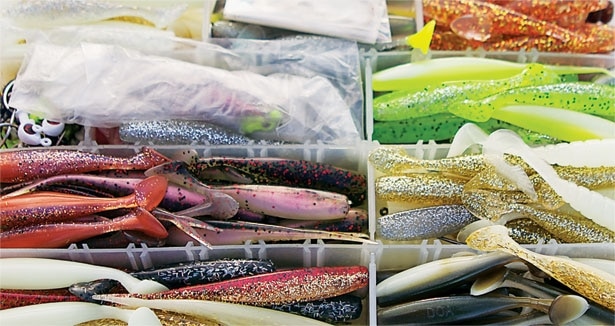
If inshore game fish were ranked like sports teams, restaurants and hit songs, snook would be in the top five. Maybe even the top three. The common snook, the most prevalent and largest of the family, is anything but common in fighting ability. Capt. Rick Grassett, a Sarasota, Florida, lure and fly-fishing specialist who has been matching wits with snook for 21 years, agrees.
“Snook have it all,” he told me as we idled up the Intracoastal Waterway near Venice, Florida, last November during an evening dock trip. “They hit hard, run fast, jump and know how to fight smart. They are like largemouth bass on steroids. If a redfish is an SUV, a snook is a sports car!” For the next few hours, Grassett proceeded to give me a tutorial on how he consistently catches even the wariest of snook.
**Starting Line
**A lighted residential boat dock that illuminated the surrounding water was our first stop.
“When fishing docks and bridge pilings, I look for good tidal flow and deep water,” Grassett explained. “Older docks with oysters or barnacles on the pilings or oyster shells on the bottom are best. I fish certain docks on incoming tides and others on outgoing. It depends mainly on where the light is. I set up on the uptide side of that so the fly or lure swings naturally through the illuminated water.”
The majority of Grassett’s night trips occur south of Sarasota, near Venice. The stretch of water near the pass is well-known as Snook Alley because of the abundance of fish and lights. Four nearby bays and access to the Gulf of Mexico create a flushing action that attracts bait and snook alike. “It’s an area that gets fished pretty heavily, but that doesn’t seem to bother the snook,” Grassett said.
Those resident snook, which average 2 to 4 pounds, feast on a diet of small shrimp and glass minnows that are attracted by the overhead lights. It’s the perfect scenario for fly-fishing or casting small lures on light spinning tackle. The snook usually lurk just below the surface, near the shadow line.

**Victory Lap
**Fly gear is especially effective because the fish key in on small baits, and the fly offers a subtle presentation. It’s also great sport, as I soon discovered.
Grassett instructs his anglers to cast beyond the rim of light and let the fly sweep through the illuminated cone, taking up slack as it does. The same technique works well with smaller soft-plastic jigs, like the D.O.A. C.A.L. series shad tails or 4-inch jerkbaits rigged weedless or with a 1/8-ounce jig head.
“The key when selecting lures is to match the bait and size,” Grassett explained. “Most dock fish are targeting smaller baits, but in the spring, when the natural shrimp get bigger, 1/4-ounce plastic shrimp are very effective.
“When the bite is really on, I may get as many as 10 fish off a dock before I move,” he said. “Other nights I might only catch a couple before they shut down and I try another spot. It just depends on how aggressive they are. If you get a good fish, the first thing it’ll do is run back under the dock. Moving tides are best, especially on a new moon, because the shadow lines are more distinct. Dock fishing is good all year long, but the winter months are prime. Those fish will continue to feed until the water temperatures dip below 60 degrees.” Water temperatures dictate daytime snook tactics too.
**Rules of the Road
**The next morning, Grassett and I launched in Sarasota Bay only to be greeted by an early cold front and easterly winds. With the cooling water, the fish had moved off the beaches and scattered into the bay. By the middle of March, many of those fish return to the beach troughs, Grassett said. As we cast jigs along the shore and over flats, the soft-spoken guide explained his daytime strategy.
“Ideal flats depths are 18 inches to three feet,” he told me. “I look for snook along the edges of bars or in potholes on the flats. With really big tides, I’ll also work along mangrove shorelines. You don’t catch as many as at night, but those you catch are quality fish. A big snook for the Sarasota area is a 30-incher-plus.”
Grassett typically uses soft-plastic lures during the day, although topwater plugs like MirrOlure Top Dogs and Heddon Zara Spooks are also good choices. On clear days Grassett ties on brighter jigs or jerkbaits, such as silver and glow patterns, while in overcast conditions he goes with darker colors. Contrasting colors, like in D.O.A. Carbonated lures, also trigger plenty of strikes.
“I like to slowly swim the shad tails with the occasional subtle twitch,” he said. “With the jerkbaits, I tell my anglers to give it a very distinct twitch with the rod tip, let it fall and repeat. With either, I’m using the lightest jig head I can get away with, usually 1/16-ounce. That helps it from getting hung up on the bottom. And I’ll often add a chug head and keep the rod tip up when it first lands so it spits water. That’s real enticing.”
The last two winters in Florida have been hard on cold-sensitive snook. Those that survived the frigid conditions are that much tougher and challenging now. But that’s OK with Grassett. After all, you don’t get to the top of the rankings by being a wuss.

Trip Planner
Rods: 7-foot medium-action spinning rods with light tips for casting long distances; 7-or 8-weight fly rods.
Reels: 3000-class spinning reels; 7- to 9-weight fly reels.
Lines: 15-pound braid for spinning, with up to 40-pound fluorocarbon leader; 8-weight intermediate fly line with a sinking tip or a full intermediate sinking line.
Lures and flies: Natural and contrasting soft-plastic shad tails and small jerkbaits on 1/16- to 1/8-ounce red or chartreuse jig heads, such as the D.O.A. C.A.L., Arkansas Glow and Glow Holo Flake. The lures can also be rigged weedless with worm-style hooks and pinch weights. Plastic shrimp, 1/4-ounce, in the spring when shrimp are larger. Hard-plastic topwater plugs like MirrOlure Top Dogs or Heddon Zara Spooks in various colors on the flats. Smaller fly patterns like the Grassett Snook Minnow, shrimp imitations and Clouser Minnows around docks and bridges at night.
Regarding leader size, Grassett says, “I normally use 30-pound-test for the fluorocarbon tippet, but if the fish are finicky, I’ll downsize. Or if we’re getting a lot of bites, I’ll bump up as high as 40-pound. The key is checking the leader constantly. If it gets scuffed from a bite or a piling, I’ll snip it back or change it immediately.”
***
Snook are particularly vulnerable to cold weather, and the fishing season is closely regulated by the state when impact does occur. Currently, keeping snook is prohibited, but catch-and-release fishing is allowed. When the season is open, a Florida fishing license and a snook stamp are required. Details on seasons and license requirements are at myfwc.com.
What: Snook.
When: Year-round catch-and-release.
Where: West coast of Florida between Sarasota and Venice; Fiesta Key; Intracoastal Waterway.
Who: Snook are a top game fish on Florida’s west coast, and local guides are some of the best and most professional you’ll find anywhere. Here are few contacts to help you get started.
Capt. Rick Grassett
941-923-7799
www.snookfin-addict.com
CB’s Saltwater Outfitters
Siesta Key941-349-4400
www.cbsoutfitters.com
Capt. Kelly Stilwell
941-376-0605
Capt. Ed Hurst
941-925-1871
Capt. Roy String
941-238-7861
Accommodations: Perfect for both anglers and their families, Siesta Key Suites combines history with comfortable ambience. The Ringling Beach House and adjacent lodgings offer accommodations ranging from efficiencies up to two-bedroom suites with full kitchens. The resort is across the street from the beach and within blocks of downtown, with access to restaurants, a grocery store, a pharmacy and night life.
Siesta Key Suites
941-349-1236
siestakeysuites.com









